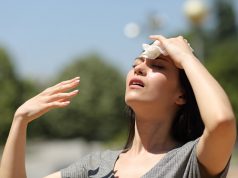 Hair Care with Professor Dr. Wedad Mostafa
Hair Care with Professor Dr. Wedad Mostafa
As summer approaches, with days spent enjoying sun and sea, the eternal challenge of keeping our tresses nourished and glossy looms on the horizon. Cairo West Magazine sought advice from leading dermatologist, Professor Dr. Wedad Mostafa, to learn more about the path to healthy hair.
CWM: Is hair alive or dead?
WM: Although hair, made of a protein; keratin, is an apparently ‘dead’ part of our bodies, and can be cut without pain, roots from which it originates lying deep inside the skin are ‘living’. They are so alive that all health events are reflected upon its growth. Hair root cells represent the second most active cells in the body after bone marrow cells where all blood elements develop. Any compromise in health is thus reflected on hair. Overexposure to hair dyes, chemicals, chlorinated or salty water may lead to structural hair damage.
When do you need to do a consultation?
When hair falls at a much higher rate than usual, urgent assessment is needed. Although it is well known that hair renewal is a continuous process, it is a very subtle process that is hardly noticeable. When hair falls visibly, blocks the drain, is on your shoulders, fills your brush, all this is alarming. And although this may be a normal happening in seasonal hair shedding, it may not be at most other times.
What is involved in a consultation?
Patients need to address their hair problems with a specialist and on a devoted visit giving a detailed history of chronic illnesses and recent health events in preceding months, medications taken, cosmetic procedures done, any hair treatment prescribed and recent investigations. Patient evaluation and examination requires time and usually needs in-office procedures such as hair pull, hair plucking and trichoscopic evaluation and not infrequently several laboratory investigations are requested. A skin sample (biopsy) under local anesthesia is occasionally required for the work up when the diagnosis is not evident after office examination and laboratory investigations.
What makes hair fall after diet or with some diseases?
Highly active cells as in hair roots need a sufficient supply of all nutrients. This means a healthy diet rich in proteins, fats, vitamins and minerals including trace elements, present in minute amounts in the diet, but essential parts for enzymes of cell division and multiplication. Therefore those who follow restricted nutritional regimes or lose weight rapidly on crash diets are very likely to have hair falling out a few weeks after starting such diets. Thyroid gland activity impairment may present with hair fall, breakability and dullness even before other symptoms of the disease. In autoimmune disease such systemic lupus erythematosus (LE) hair loss may be a more alarming sign to patients than body aches, muscle and joint pains.
What must we include in our diet to have strong, shiny hair?
One of the crucial minerals for hair health and maintenance is iron. Anemia, and in particular iron deficiency is a very frequent cause of hair thinning and loss. Unfortunately many sufferers go without notice as blood testing shows normal blood picture and hemoglobin percentage. However, a complete work up for iron and its stores is fundamental to avoid delays in diagnosis and management. Normal supply of zinc, copper, selenium, magnesium, biotin, pantothenic acid and vitamin D are critical. However, excess vitamins A and K can induce hair loss.
What causes sudden hair loss?
Those who go through periods of severe psychological stress, such as separation or divorce, death of a dear family member etc. may develop sudden hair fall. In those who undergo surgery, women after childbirth and following prolonged fevers, visible severe hair fall occurs. This type is usually reversed after proper evaluation and management. However, hair loss due to such health events may follow a more prolonged course that may continue for years or unmask an underlying genetic or acquired disorder.
What is alopecia areata?
Although alopecia areata, as its name signifies represents hair loss at a certain area, usually scalp, beard or moustache, a severe form may start as a diffuse hair fall and may run unrecognized. This disease is autoimmune and has genetic background as well and may be associated with other autoimmune diseases such as thyroid disease.
Does diabetes affect hair?
While there are common complaints of hair loss from persons with diabetes, there is no clear-cut evidence of a causal relation, but in diabetics with metabolic syndrome which also includes cardiovascular disease and obesity, the condition of female pattern hair loss (FPHL) is frequently seen.
What is female pattern hair loss?
It is by far the most common cause of hair thinning and represents the female counterpart of male baldness. Here the hairs gradually become thinner and less pigmented until the scalp shows through. Although it can be controlled and somewhat arrested by proper evaluation and management, early diagnosis is a must. It is a genetically determined disease with some hormonal influence on the hair follicles. It may be associated with increased body and facial hair, acne and/or menstrual irregularities in polycystic ovary syndrome where the balance between male and female blood hormones is disturbed. However, FPHL usually occurs singly and with normal blood hormones. It is uncommon in teenagers but usually starts in the thirties and has another peak after menopause.
What causes baldness in men?
Baldness in men as is known is a genetic disorder that may start in the twenties or thirties. It may progress rapidly or slowly with a repeated pattern in the family where father and son bald similarly. The genes are responsible for the transfer of certain hormones at the hair roots that switch off the hair follicle with production of smaller, thinner hairs that gradually get lost.
Is hair thinning in FPHL and male baldness reversible?
At onset in both male baldness and female pattern hair loss, part of the process is reversible, but in advanced cases nothing can be done as regards medical treatment.
Is dandruff harmful?
Dandruff is a common condition associated with hair loss that is frequently overlooked and is regarded by many as simple flakiness. Dandruff denotes that the normally present yeast in the hair follicle have changed their habits and are causing inflammation. This yeast thrives on oily skin, so whatever influences scalp oiliness such as infrequent shampooing or adding oils leads to their flourishing and turns on an inflammatory process which causes acceleration of hair loss, particularly in male baldness and female pattern hair loss. Treating dandruff is imperative before starting hair loss management.
Why do shed hairs have different lengths?
Frequently hairs fall from the scalp by the roots but many times hairs break at any part of their length. With frequent coloring, straightening or processing with the en vogue keratin or protein treatments, hairs get a visible effect with underlying structural abnormalities. A change in the hair protein made of particular arrangements of amino acids occurs which makes the hairs lusterless, brittle, fragile, easily breakable and with split or frayed ends. Much of the damage occurs in the outer protective layer of the hair fiber, the cuticle. So, normal processes like shampooing, hair drying and brushing lead to hair breakage at the weakest points. It is therefore advisable not to undergo multiple nor frequent hair procedures to avoid irreversible hair damage.
Can hair graying be delayed?
Hair graying is mainly due to aging, but influenced by genetics. However, factors such as stress, malnutrition, environment and smoking do contribute to graying. Thus, the process may be slowed down by avoiding such stressors.
Is there anything we can do to stimulate hair growth?
Improvement of circulation in general and blood flow to the scalp in particular to assure that all the necessary elements and nutrients reach the scalp is of utmost importance. This is achieved by general measures against environmental pollution, regular exercise in fresh air, antioxidants, and proper hydration. Gentle massage while shampooing or brushing may be helpful.
What should we include in our diet to delay our hair turning gray?
A protein rich diet is essential both for the production of keratin, the hair protein and melanin the hair color protein. Foods rich in vitamin B such as whole grain bread, cereals, bananas, eggs, dairy products, poultry, meat, and green leafy vegetables are essential for maintaining healthy growth and hair color. Selenium can also help prevent gray hair. Selenium rich foods include shellfish, tuna, salmon, corn, wheat, soybeans, walnuts, Brazil nuts, and sunflower seeds. Copper rich foods are also helpful as copper deficiency leads to hair graying. Foods containing high amounts of copper are turnip greens, spinach, beef liver, sunflower seeds, cashews, lentils, almonds, fish and seafood, egg yolk, and mushrooms.
What treatments are available for hair growth?
Frequently used treatments include agents that antagonize enzymatic change in hair follicles, potentiate local circulation, and supplement necessary elements such as amino acids, minerals and vitamins. Additionally, low level laser and light treatments may be beneficial. Local scalp applications as well as local injections such as in mesotherapy and platelet rich plasma have proven useful. Oils however are of limited value except for cuticle repair and should not be applied on the scalp to avoid growth of yeast, dermatitis and dandruff.
 BIO:
BIO:
Professor Dr. Dr Wedad Mostafa
Kasr El Einy Faculty of Medicine
Department of Dermatology
Oasis Clinics – Sheikh Zayed
Contact Details:
Oasis Clinics
Karma 1 Office Buildings, 2nd Floor
Sheikh Zayed, Egypt
Mobile:
(+2) 0100-4000-777
(+2) 0100-4000-776
(+2) 0100-4000-778
Landline:
(+202) 37-942-522
(+202) 37-942-523
(+202) 37-942-013
wedad_mostafa@kasralainy.edu.eg







